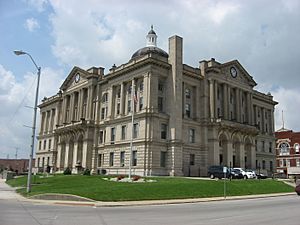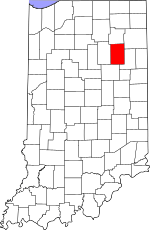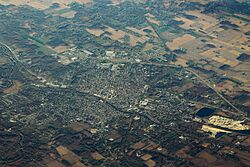Huntington County, Indiana facts for kids
Quick facts for kids
Huntington County
|
|
|---|---|

Huntington County Courthouse in Huntington
|
|

Location within the U.S. state of Indiana
|
|
 Indiana's location within the U.S. |
|
| Country | |
| State | |
| Founded | February 2, 1832 (authorized) May 5, 1834 (organized) |
| Named for | Samuel Huntington |
| Seat | Huntington |
| Largest city | Huntington |
| Area | |
| • Total | 387.72 sq mi (1,004.2 km2) |
| • Land | 382.65 sq mi (991.1 km2) |
| • Water | 5.07 sq mi (13.1 km2) 1.31%% |
| Population
(2020)
|
|
| • Total | 36,662 |
| • Estimate
(2023)
|
36,781 |
| • Density | 94.5579/sq mi (36.5090/km2) |
| Time zone | UTC−5 (Eastern) |
| • Summer (DST) | UTC−4 (EDT) |
| Congressional district | 3rd |
| Indiana county number 35 | |
Huntington County is a county in the U.S. state of Indiana. According to the 2020 United States Census, the population was 36,662. The county seat (and only city) is Huntington. Huntington County comprises the Huntington, Indiana micropolitan statistical area and is included in the Fort Wayne–Huntington–Auburn Combined Statistical Area.
Contents
History

Huntington County was organized from the previously unorganized Indiana Territory and lands gained by the Adams New Purchase of 1818. The county's creation was authorized by an act of the Indiana state legislature dated February 2, 1832. Organization of the county's governing structure began on May 5, 1834. The first non–Native American settlers in what has since become Huntington County were a group of 29 farm families from Connecticut who arrived in the early 1830s. These were "Yankee" settlers, meaning they were descended from the English Puritans who settled New England in the colonial era. These settlers were able to get to what has since become Huntington County due to the construction of the Wabash and Erie Canal, which was a shipping canal that connected the Great Lakes to the Ohio River by way of a manmade waterway. When they arrived in what has since become Huntington County, the settlers from Connecticut found dense virgin forest and wild prairie. The original 29 "Yankee" families from Connecticut laid out roads; built a post office; established post routes; and built a town hall, a church, and a schoolhouse from the trees in the area that they cut down. The county was named for Samuel Huntington, who signed the Declaration of Independence and the Articles of Confederation. He was also president of the Continental Congress under the Articles of Confederation.
Geography
The terrain of Huntington County consists of low rolling hills, completely devoted to agriculture or urban development. The Wabash River flows to the west through the upper-central part of the county, while the Salamonie River flows to the west through the lower part. Its highest point (about 925 feet (282 m) above sea level) is at the southwest corner. According to the 2010 census, the county has a total area of 387.72 square miles (1,004.2 km2), of which 382.65 square miles (991.1 km2) (or 98.69%) is land and 5.07 square miles (13.1 km2) (or 1.31%) is water.
Adjacent counties
- Whitley County – north
- Allen County – northeast
- Wells County – east
- Grant County – south
- Wabash County – west
Highways
City and towns
- Andrews
- Huntington (city)
- Markle (partial)
- Mount Etna
- Roanoke
- Warren
Townships
- Clear Creek
- Dallas
- Huntington
- Jackson
- Jefferson
- Lancaster
- Polk
- Rock Creek
- Salamonie
- Union
- Warren
- Wayne
Unincorporated communities
Protected areas
- JE Roush Fish and Wildlife Area
- Lost Bridge State Recreation Area
Notable people
Public servants
- Samuel E. Cook (1860–1946), U.S. congressman
- J. Danforth Quayle, U.S. representative, senator, vice-president
- J. Edward Roush (1920–2004), U.S. representative, father of "911"
- Elizebeth (Smith) Friedman (1892–1980), author and pioneer in cryptology during WWI to WWII era, called "America's first female cryptanalyst"
Celebrities
- Chris Schenkel (1923–2005), sportscaster
- Archbishop John F. Noll (1875–1956), founded Catholic newspaper Our Sunday Visitor, founded Victory Noll and St. Felix Monastery.
Artists
- Mick Mars, guitarist for Mötley Crüe.
Athletes
- Gary Dilley, Tokyo Olympics swimmer
- George Haines, Olympic Women's Swim coach
- Chris Kramer, professional basketball player. Kramer played college basketball at Purdue University where he was two-time Big Ten Defensive Player of the Year.
Points of interest
- Huntington County Historical Museum
- Huntington University Arboretum and Botanical Garden
- Huntington University
- Edward Roush Lake
- Merillat Centre for the Arts
- Our Sunday Visitor Corporate Headquarters
- The Forks Of The Wabash
- The Indiana Room Genealogy Center
- Tel-Hy Nature Preserve
- United States Vice Presidential Museum
- Victory Noll Center
Education
School district
- Huntington County Community School Corporation
Private schools
- Huntington Area Home Educators
- Huntington Catholic School
Higher education
- Huntington University
News and media
Newspapers
- The Herald-Press daily newspaper
- The Huntington County TAB
- Warren Weekly
- HuntingtonFreePress
- Huntingtonian
Radio
- WBZQ 1300 AM
- Huntington North High School WVSH Viking Radio
- WQHU-LP Huntington University Radio WQHU 105.5-FM Forester Radio
Climate and weather
| Weather chart for Huntington, Indiana | |||||||||||||||||||||||||||||||||||||||||||||||
|---|---|---|---|---|---|---|---|---|---|---|---|---|---|---|---|---|---|---|---|---|---|---|---|---|---|---|---|---|---|---|---|---|---|---|---|---|---|---|---|---|---|---|---|---|---|---|---|
| J | F | M | A | M | J | J | A | S | O | N | D | ||||||||||||||||||||||||||||||||||||
|
2
32
16
|
1.8
37
18
|
2.9
48
28
|
3.4
61
38
|
4.1
73
48
|
4.4
83
58
|
3.6
87
62
|
3.6
84
60
|
2.8
78
52
|
2.8
65
41
|
2.9
50
32
|
2.8
38
22
|
||||||||||||||||||||||||||||||||||||
| temperatures in °F precipitation totals in inches source: The Weather Channel |
|||||||||||||||||||||||||||||||||||||||||||||||
|
Metric conversion
|
|||||||||||||||||||||||||||||||||||||||||||||||
In recent years, average temperatures in Huntington have ranged from a low of 16 °F (−9 °C) in January to a high of 87 °F (31 °C) in July, although a record low of −28 °F (−33 °C) was recorded in January 1982 and a record high of 105 °F (41 °C) was recorded in June 1988. Average monthly precipitation ranged from 1.82 inches (46 mm) in February to 4.37 inches (111 mm) in June.
Government
The county government is a constitutional body, and is granted specific powers by the Constitution of Indiana, and by the Indiana Code.
County Council: The fiscal branch of the county government; controls spending and revenue collection in the county. Representatives, elected to four-year terms from county districts, are responsible for setting salaries, the annual budget, and special spending. The council has limited authority to impose local taxes, in the form of an income and property tax that is subject to state level approval, excise taxes, and service taxes.
Board of Commissioners: The executive and legislative body of the county. The commissioners are elected county-wide to staggered four-year terms. One commissioner serves as president. The commissioners are charged with collecting revenue and managing the county government.
Court: The county maintains a small claims court that handles civil cases. The judge on the court is elected to a term of four years and must be a member of the Indiana Bar Association. The judge is assisted by a constable who is also elected to a four-year term. In some cases, court decisions can be appealed to the state level circuit court.
County Officials: The county has other elected offices, including sheriff, coroner, auditor, treasurer, recorder, surveyor, and circuit court clerk. These officers are elected to four-year terms. Members elected to county government positions are required to declare party affiliations and to be residents of the county.
Huntington County is part of Indiana's 3rd congressional district; Indiana Senate districts 17 and 19; and Indiana House of Representatives district 50.
Demographics
| Historical population | |||
|---|---|---|---|
| Census | Pop. | %± | |
| 1840 | 1,579 | — | |
| 1850 | 7,850 | 397.2% | |
| 1860 | 14,867 | 89.4% | |
| 1870 | 19,036 | 28.0% | |
| 1880 | 21,805 | 14.5% | |
| 1890 | 27,644 | 26.8% | |
| 1900 | 28,901 | 4.5% | |
| 1910 | 28,982 | 0.3% | |
| 1920 | 31,671 | 9.3% | |
| 1930 | 29,073 | −8.2% | |
| 1940 | 29,931 | 3.0% | |
| 1950 | 31,400 | 4.9% | |
| 1960 | 33,814 | 7.7% | |
| 1970 | 34,970 | 3.4% | |
| 1980 | 35,596 | 1.8% | |
| 1990 | 35,427 | −0.5% | |
| 2000 | 38,075 | 7.5% | |
| 2010 | 37,124 | −2.5% | |
| 2020 | 36,662 | −1.2% | |
| 2023 (est.) | 36,781 | −0.9% | |
| US Decennial Census 1790–1960 1900–1990 1990–2000 2010–2013 |
|||
2010 census
As of the 2010 United States Census, there were 37,124 people, 14,218 households, and 10,074 families in the county. The population density was 97.0 inhabitants per square mile (37.5/km2). There were 15,805 housing units at an average density of 41.3 per square mile (15.9/km2). The racial makeup of the county was 97.1% white, 0.4% Asian, 0.4% American Indian, 0.4% black or African American, 0.5% from other races, and 1.1% from two or more races. Those of Hispanic or Latino origin made up 1.7% of the population. In terms of ancestry, 37.9% were German, 14.9% were Irish, 12.9% were American, and 12.1% were English.
Of the 14,218 households, 32.3% had children under the age of 18 living with them, 56.5% were married couples living together, 9.9% had a female householder with no husband present, 29.1% were non-families, and 24.4% of all households were made up of individuals. The average household size was 2.52 and the average family size was 2.97. The median age was 39.0 years.
The median income for a household in the county was $47,697 and the median income for a family was $55,630. Males had a median income of $41,648 versus $30,218 for females. The per capita income for the county was $21,575. About 7.7% of families and 11.4% of the population were below the poverty line, including 15.6% of those under age 18 and 9.8% of those age 65 or over.
See also
 In Spanish: Condado de Huntington para niños
In Spanish: Condado de Huntington para niños

